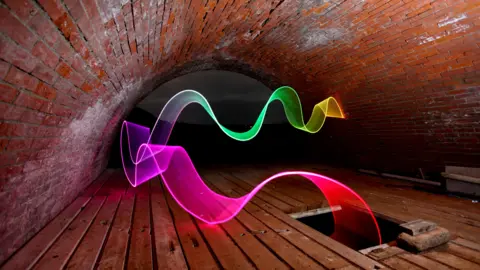[ad_1]
 David Gilliver
David GilliverIf you have ever written your name in the air with a sparkler on bonfire night then you have experimented with light painting.
Baffled by the “lines of light floating in mid-air”, Scottish photographer David Gilliver knew he had to try capturing them with his camera.
“I thought it was like sorcery, it’s like magic,” he says.
For 15 years, Mr Gilliver has been a pioneer in the technique of light painting.
Now, one of his pictures – which he has called Where Rainbows Sleep – has been shortlisted for this year’s British Photography Awards in its newest category – best low light photograph.
‘Where rainbows sleep’
Picture this: Mr Gilliver is stood in a pitch black fishing boat hut, dressed head to toe in dark clothing, holding a “light sabre”.
No, he’s not re-enacting Star Wars – this is just how the process of making the photo begins.
To blend into the low-light background, Mr Gilliver must imitate one of film’s greatest villains.
He channels his inner Darth Vader but instead of “the force” he uses a long exposure photography technique, keeping the shutter open for anything from 30 seconds to 20 minutes.
His camera, which he controls remotely, is at the other end of the room securely fixed to a tripod, because even the slightest movement will cause a blurring of the image.
Mr Gilliver moves towards the camera, swooshing his light sabre before disappearing down the trap door.
The exposure length gives him enough time to fire a flash gun manually to illuminate the boat hut surroundings.
 David Gilliver
David Gilliver David Gilliver
David Gilliver“Simple is often best”, Mr Gilliver says, when it comes to creating his waves of light.
But he also loves to experiment.
In another photo, he uses butterfly keyrings with battery-operated lights to create an image of multiple floating butterflies.
He also created an eerie orb sitting within the ancient Callanish stones on the Isle of Lewis, by swinging a light on the end of a string like a lasso during the long exposure time.
 David Gilliver
David GilliverThe 45-year-old Glasgow School of Art graduate has always had an artistic eye.
However, making a living as an artist initially proved difficult and he ended up working in finance in the Channel Islands for 14 years.
He became “utterly obsessed” with light painting to capture the “magical” landscapes of Guernsey at night.
When he moved back to Scotland in 2015, he says the “dramatic” and “iconic” backdrops of the country kept his creativity alive.
In 2018, he abandoned his 9 to 5 life to finally take up photography full time.
 David Gilliver
David Gilliver David Gilliver
David GilliverWhen he started posting his light paintings online, he says most people would ask him how he did it.
Photographers would ask to come with him while he created his images, he says.
Mr Gilliver, who lives in Gartcosh, North Lanarkshire, now teaches his own workshops across the UK.
He says most people think the technique is hard to understand but actually it is “very accessible” once people start to experiment and play with light.
He says teaching “found” him and he enjoys people’s natural curiosity.
“Watching their eyes light up as they begin to learn what the creative possibilities are of this amazing art form is one of the many joys of teaching,” he says.
 David Gilliver
David GilliverAlong with light painting, Mr Gilliver has a large portfolio of macro photography.
The technique is a form of extreme close-up photography and can be used to capture small objects, flowers and insects.
Mr Gilliver plays around with imaginative scenarios using small figurines.
His photos range from iconic film scenes to handling more serious topics.
 David Gilliver
David GilliverHe is no stranger to the British Photography Awards, having already won the best macro photograph category in 2022 by turning a face mask into a swimming pool for a Covid pandemic image.
“Delivering a serious message without trivialising what you’re talking about is the key,” he says.
This year, his recreation of Leonardo DiCaprio and Kate Winslet’s famous “I’m flying” scene from the blockbuster movie Titanic has been shortlisted in the macro category.
It depicts a miniature Jack and Rose recreating the famous scene on top of an electric iron.
 David Gilliver
David GilliverMacro or light painting?
The photographer says it would be unfair to choose which of photographic forms he prefers.
He says macro photography exercises his imagination but light painting feels more like an experience.
The “experiential” side of light painting is what makes the “incredible process reign supreme”, he says.
Mr Gilliver has been shortlisted for three categories in this year’s British Photography Awards, for best macro, low light and commercial photography.
The awards will take place on 4 November.
[ad_2]
Source link




